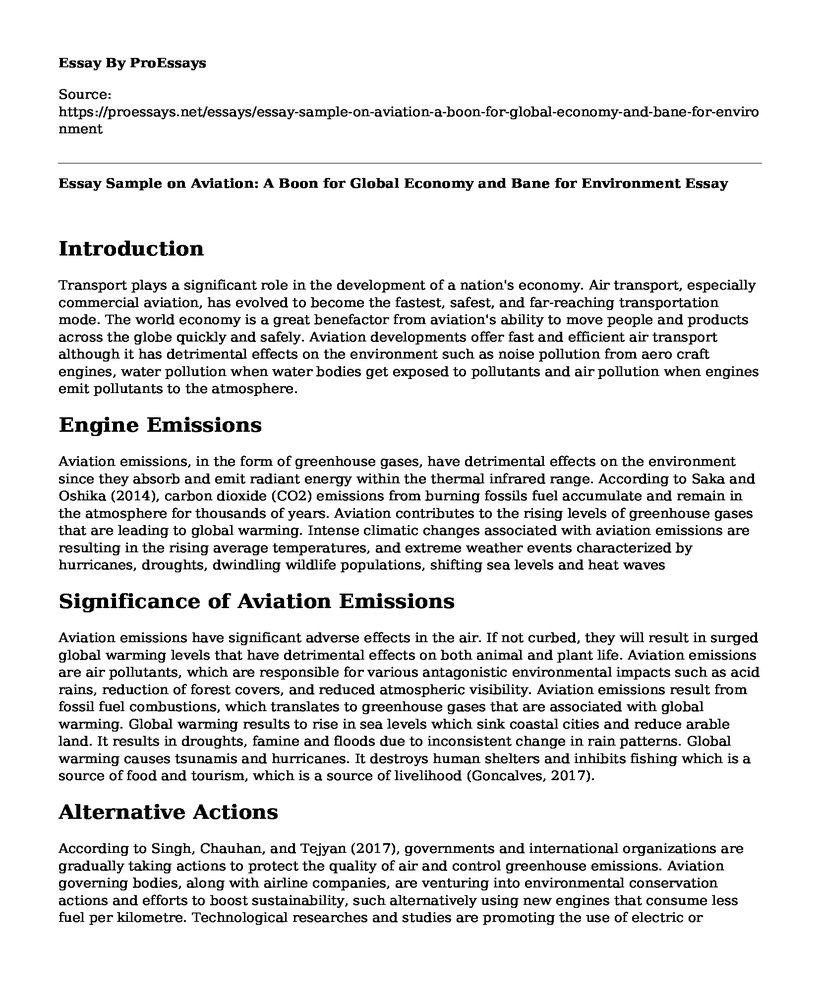Introduction
Transport plays a significant role in the development of a nation's economy. Air transport, especially commercial aviation, has evolved to become the fastest, safest, and far-reaching transportation mode. The world economy is a great benefactor from aviation's ability to move people and products across the globe quickly and safely. Aviation developments offer fast and efficient air transport although it has detrimental effects on the environment such as noise pollution from aero craft engines, water pollution when water bodies get exposed to pollutants and air pollution when engines emit pollutants to the atmosphere.
Engine Emissions
Aviation emissions, in the form of greenhouse gases, have detrimental effects on the environment since they absorb and emit radiant energy within the thermal infrared range. According to Saka and Oshika (2014), carbon dioxide (CO2) emissions from burning fossils fuel accumulate and remain in the atmosphere for thousands of years. Aviation contributes to the rising levels of greenhouse gases that are leading to global warming. Intense climatic changes associated with aviation emissions are resulting in the rising average temperatures, and extreme weather events characterized by hurricanes, droughts, dwindling wildlife populations, shifting sea levels and heat waves
Significance of Aviation Emissions
Aviation emissions have significant adverse effects in the air. If not curbed, they will result in surged global warming levels that have detrimental effects on both animal and plant life. Aviation emissions are air pollutants, which are responsible for various antagonistic environmental impacts such as acid rains, reduction of forest covers, and reduced atmospheric visibility. Aviation emissions result from fossil fuel combustions, which translates to greenhouse gases that are associated with global warming. Global warming results to rise in sea levels which sink coastal cities and reduce arable land. It results in droughts, famine and floods due to inconsistent change in rain patterns. Global warming causes tsunamis and hurricanes. It destroys human shelters and inhibits fishing which is a source of food and tourism, which is a source of livelihood (Goncalves, 2017).
Alternative Actions
According to Singh, Chauhan, and Tejyan (2017), governments and international organizations are gradually taking actions to protect the quality of air and control greenhouse emissions. Aviation governing bodies, along with airline companies, are venturing into environmental conservation actions and efforts to boost sustainability, such alternatively using new engines that consume less fuel per kilometre. Technological researches and studies are promoting the use of electric or battery-powered aero crafts such as drones in delivering cargo; it translates to zero emissions (Winchester, Malina, Staples, & Barrett, 2015). Governments and aviation companies are promoting the extensive use of aviation biofuels, which will substitute fossil fuels since they emit up to eighty percent less carbon into the atmosphere (Winchester, Malina, Staples, & Barrett, 2015).
Recommendations
Governments and aviation management bodies should consider establishing legislations and policies that conserve the environment, such as restricting the use of old aero engines that emit lots of carbon gasses. Aviation companies should venture and invest in solar, electric or biofuels engines which are less harmful to the environment. Collaborations such as those between aircraft manufacturers such as Boeing and different airline companies can get utilized in developing technologies that produce fewer greenhouse emissions.
Reference
Goncalves, K. (2017). Climate Change and International Civil Aviation Negotiations. Contexto Internacional, 39(2), 443-458. Retrieved from: http://www.scielo.br/scielo.php?pid=S0102-85292017005001109&script=sci_arttext.
Saka, C., & Oshika, T. (2014). Disclosure effects, carbon emissions and corporatevalue. Sustainability Accounting, Management and Policy Journal. Retrieved from: https://pdfs.semanticscholar.org/a985/c6d1fc4cbb16608c3648291c09245324a9f4.pdf.
Singh, V., Chauhan, S., & Tejyan, S. (2017). Greenhouse gas emission reduction potentials in air transport: a structural equation modelling-based multi-group analysis. Technology Analysis & Strategic Management, 29(4), 442-461. Retrieved from: https://www.tandfonline.com/doi/abs/10.1080/09537325.2016.1215422.
Winchester, N., Malina, R., Staples, M, & Barrett, S (2015). The impact of advancedbiofuels on aviation emissions and operations in the US. Energy Economics, 49, 482-491. Retrieved from: https://www.gtap.agecon.purdue.edu/resources/download/7290.pdf.
Cite this page
Essay Sample on Aviation: A Boon for Global Economy and Bane for Environment. (2023, Apr 10). Retrieved from https://proessays.net/essays/essay-sample-on-aviation-a-boon-for-global-economy-and-bane-for-environment
If you are the original author of this essay and no longer wish to have it published on the ProEssays website, please click below to request its removal:
- Cubana Flight 972 Accident Essay Example
- Essay Example on Adapting to Disruptive Forces in Aviation and Aerospace Industries
- SWOT Analysis of Southwest Airlines
- The US Political System: Partisan Governance and Ideology
- Boeing: The Global Aircraft Manufacturing Giant - Essay Sample
- Essay Sample on Bombardier: Canadian Manufacturer of Business Jets & Rails
- Napoleon: A Life of Family and French Military







